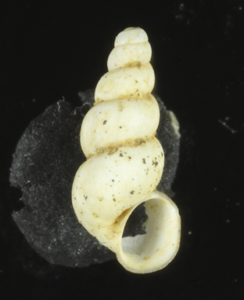Specify Bythiospeum
 The mollusks fauna of Germany has been already well investigated and taxonomically classified since several decades, although there has been some changes due to genetic analysis more recently. But there are some genus where no defined species concept seem to exist because there are only few data available. One of those genus is Bythiospeum (Boethers 1984, Haase 1995, Bichain, Boisselier-Dubayle et al. 2007).
The mollusks fauna of Germany has been already well investigated and taxonomically classified since several decades, although there has been some changes due to genetic analysis more recently. But there are some genus where no defined species concept seem to exist because there are only few data available. One of those genus is Bythiospeum (Boethers 1984, Haase 1995, Bichain, Boisselier-Dubayle et al. 2007).
Due to new methods like genetic analysis and digital measuring methods combined with geometric morphometrics, it is possible to get more and new information about this genus (Bookstein 1996, Andrea 2014).
In the frame of an advanced course in applied bioinformatics at the University of Konstanz during the master studies of biological sciences, a project has been contrived, to help people identifying the species of the genus of Bythiospeum. Unfortunately, the results are not correct, yet and the time during this course was too scarce to realize the program. But it seems possible to realize a functional version of this program in the future.
What is Bythiospeum?
The genus Bythiospeum of the family of Hydrobiidae contains of more than 70 single species (Colling, Falkner et al. 2008). The size of the small freshwater spring snails ranges from two to four millimeters. They have a tower to conical shaped shell. The shell is slightly transparent, white to amber (Glöer 2002). Shells of dead animals can change the color of their shell very quick due to mineralization and calcification. The very slightly expressed mouth seam is continuous and sharp. It is slightly widened and the mouth sometimes sticks a bit out (Glöer 2002). The beginning of the first whorl at the tip of the shells is often hard to identify, so the amount of whorls is hard to determine exactly. The problem gets more serious if the tip is grinded. Very often this is the case. They have an operculum, which is deep in the mouth (Glöer 2002).
Those Prosobranchia are hydrobioid or even stygobiotic, which means, that they occur almost exclusively in groundwater aquifers. Very few animals and empty shells can be found at springs and the most upper courses of small streams. Furthermore, they occur most likely at carstic regions with high calcium carbonate concentrations and thus alkaline water (Bernasconi 1969). But there are very few exceptions where the animals seem to live in quite acid waters in slate regions (unpublished data).
Thus, Bythiospeum may be a possible species for tracing ground water quality. But to use them in such a way and also for different further studies focusing on their life cycle and role in the ecosystem, it is necessary to have a good idea of the magnitude of biodiversity in this group, which is something we lack of knowledge.
What is the problem to identify the species?
Hydrobioid snails often lack of obvious discriminating characters making species delimitation very difficult. This results usually in local species with the locality as best delimiting character. More recently it is possible to determine the species with genetic approaches to get a more reliable idea of the taxonomy in those taxa (Glöer 2002, Bichain, Boisselier-Dubayle et al. 2007).
Do we need a software for identification?
In an earlier study it was possible to delimitate species of the genus Bythiospeum using morphological approaches and validating them with genetic data with shells of different locations in Baden-Württemberg, Germany. It was even possible to identify the exact locality where the shells come from. This and further yet unpublished studies have also shown, that there are only very few species existing in Germany and Switzerland in contrast to the hitherto opinions (unpublished data).
This lead to the conclusion, that it may be possible to identify all possible species of Bythiospeum by comparing them with a validated data set of analyzed shells. This would make things much easier and cheaper, when studies with Bythiospeum are conducted or one have to identify species of this genus. To make this comparison easy, available and accessible for everyone, it should be realized with a web based software that would process and compare given landmark data or pictures automatically.
Main-Sources:
- Glöer, P. (2002). Süsswassergastropoden Nord-und Mitteleuropas: Bestimmungsschlüssel, Lebensweise, Verbreitung, ConchBooks
- Haase, M. (1995). The stygobiont genus Bythiospeum in Austria - a basic revision and anatomical description of B-CF-GEYERI from Vienna (Caenogastropoda, Hydrobiidae). American Malacological Bulletin
- Bookstein, F. L. (1996). Biometrics, biomathematics and the morphometric synthesis. Bulletin of mathematical biology
- Andrea, C. (2014). Missing the third dimension in geometric morphometrics: how to assess if 2D images really are a good proxy for 3D structures? the Italian Journal of Mammalogy
- My own, yet unpublished study




